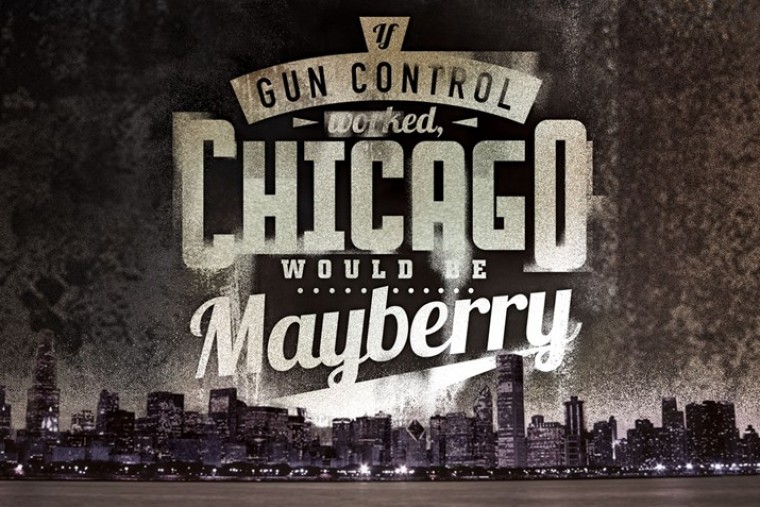Have gun control advocates ever been right?
Though the concept of the powerful few disarming the populace as a means to maintain control is nothing new, modern-day anti-gun activists can trace their roots back to the mid-1970s. With a record of rhetoric and advocacy spanning four decades, they should have a few things right by now.
They haven’t.
When called upon by reporters harboring an agenda of their own, individuals unfamiliar with the gun-rights debate instinctively try to strike an intelligent balance, acknowledging hunting, self-defense and the Second Amendment, but then proclaiming, “no one needs an ‘assault rifle’.”
Gun control advocates have long feigned respect for hunting, self-defense and the Second Amendment, yet always with a qualifier such as “no one needs an ‘assault rifle.’” They’ve insisted no one wants to take guns away, just regulate them a little more. And, well, maybe take away some of the bigger ones.
While it may hold some sway over legislators and the media, the anti-gun crowd is ultimately bankrupt of evidence. A number of recent reports confirm that fact, illustrating how the gun control lobby, and even those middle-ground moderates, have been wrong at nearly every turn. You may want to have a highlighter ready as we examine some of the latest research.
More Guns, More Crime?
Gun-banners’ motives classically rest on the idea that “more guns equal more crime.” Although both sides generally agree there are “more guns,” let’s briefly examine the breathtaking rise in firearms and permits in recent history.
In 2011, Gallup noted that self-reporting of gun ownership had reached an 18-year high, with nearly half of all American households reporting firearm possession.
In the same year, the FBI reported firearm background checks reached an all-time high of 16.5 million—not even counting valid permit-holders who are exempted from additional background checks in some states. (This record was smashed by 19.6 million new background checks in 2012, and is on track to reach a new record in 2013.)If more guns really equal more crime, America should be awash in violence.However, this is not the case.
On Independence Day 2013, the Wall Street Journal reported an unprecedented surge in right-to-carry permits. Surveying a dozen states, the paper found more than half a million new permits were issued—an overall increase of 18 percent as compared to the previous year. In five years, Florida’s permits doubled, while Ohio’s tripled. The Government Accountability Office conservatively estimates that there are about 8 million carry permit holders nationwide.
According to records from the Bureau of Alcohol, Tobacco, Firearms and Explosives (BATFE), domestic production of firearms has increased roughly 80 percent since 1986. And, of course, the National Rifle Association has picked up more than 600,000 new members just in the past several months.
If more guns really equal more crime, America should be awash in violence. However, this is not the case. The trends actually show that with gun ownership rising to an all-time high, violent crime has declined to half of what it was in 1991.
Federal Data
In a May 2013 report released by the Department of Justice titled “Firearm Violence, 1993-2011,” the department noted a 39-percent decline in firearm-related homicides over an 18-year period, and a 69-percent decline in nonfatal firearm crimes.
Deeming them easier to target because of their appearance and ammunition capacity, anti-gunners have once again turned up the heat on so-called “assault rifles.” However, the DOJ report notes rifles were not used in a majority of crimes and that handguns were used in 70 to 83 percent of firearm homicides and 90 percent of nonfatal firearm-related violent crimes.
The report also recorded 235,700 defensive uses of guns reported in a five-year period—an average of 47,140 per year, or 129 defensive gun uses per day. Sadly, another 44 percent of victims didn’t fight back or resist at all. (Imagine if more of them had been armed responsibly.) Of course, a large number of incidents go unreported, as illustrated in the research of scholars like John Lott and Gary Kleck.
And that so-called gun show loophole? The DOJ reports less than 2 percent of of state prison inmates incarcerated for firearm-related crimes bought their guns at flea markets or gun shows.
Then, in July 2013, the Centers for Disease Control released new numbers indicating the homicide rate for persons ages 10 to 24 hit a 30-year low in 2010.
Last year the FBI reported that violent crime in 2011 dropped for the fifth consecutive year, down 19 percent. The robbery rate declined 24 percent and the rape rate declined 15 percent. The FBI also reported 14,612 murders for the year—a 17-percent decrease from the previous 10 years. Chicago and New York, with all their restrictions on gun ownership, together accounted for more than 15 percent of the nationwide totals.
Considering that guns were only used for two-thirds of these murders, and comparing that number against the over 40,000 estimated defensive uses in 2011, firearms were used defensively nearly five times more often than in homicides.When stripped of hype and rhetoric, simple facts paint an undeniable portrait: More guns equal less crime.
Despite all this evidence, President Barack Obama asked Congress to appropriate $10 million for gun control research, and for the Institute of Medicine and National Research Council to seek the advice of gun control researchers on which gun control topics the $10 million should be spent.
The report, “Priorities for Research to Reduce the Threat of Firearm-Related Violence,” was released through the CDC in June 2013. Among other things, the report said “almost all national survey estimates indicate that defensive gun uses by victims are at least as common as offensive uses by criminals” and that “studies that directly assessed the effect of actual defensive uses of guns … have found consistently lower injury rates among gun-using crime victims compared with victims who used other self-protective strategies.”
It certainly doesn’t match apocalyptic predictions by the gun banners, who insist guns return us to the “Wild West.” When stripped of hype and rhetoric, simple facts paint an undeniable portrait: More guns equal less crime.
State Data
This same success is reproduced on the state level, thanks to NRA-supported right-to-carry laws in numerous states.
For instance, it’s commonly known that after Texas’ Right-to-Carry law passed, murder, rape and aggravated assault rates all declined. However, in a recent survey, the Texas Department of Public Safety found only 0.2 percent of all crimes committed in 2011 were committed by permit holders.
The Wichita Eagle examined all Kansas permits and found that over five years, 51,078 were issued, with only 44 permit-holders—less than one-tenth of one percent—were charged with weapons-related crimes. A quarter of these were dismissed.
The Richmond Times-Dispatch reported from 2006 to 2011, that state gun sales rose 63 percent, while gun-related offenses dropped 27 percent. Released shortly before press time, new numbers for 2013 show gun sales up another 16 percent, while violent crime declined 5 percent.
Amid a hotbed of new gun control laws, permit applications in Colorado have risen 87 percent since 2012, forcing harried sheriffs’ departments to hire new staff just to cope with the demand, while violent crimes statewide are down 3.4 percent.
Tennessee permits rose 83 percent in the last five years, while most major offenses declined nearly 3 percent.
Local Data
But surely there must be some places where gun bans make sense? College campuses are filled with irresponsible youth, bars are rife with drinking, and national parks are the unsullied shrine to tranquility and endangered species. Moderate observers often agree guns don’t belong there.
National parks are among some of the most remote and rugged wilderness in America, but some 3,760 major crimes were reported by the National Park Service in 2008, including five homicides and 37 rapes. When the NRA noted the threats posed to tourists, and the need to decriminalize concealed carry for self-protection, gun control advocates were once again incensed. “Wherever Teddy Roosevelt is, he’s got to be rolling his eyes and shaking his head,” said a Brady Campaign spokesman of the proposal. Nevertheless, the NRA prevailed and President Obama signed the bill into law.
Since then, guns have been used in self-defense against dangerous wildlife in places such as the Grand Teton and Denali national parks. The shootings are the first of their kind under the new law and protected dozens of bystanders from injury or death. Rolling his eyes, huh?Even local anti-gun activists admitted they were wrong.
Gun control advocates were livid when lawmakers in Ohio and Virginia proposed allowing permit-holders to carry into bars and restaurants serving alcohol. “Allowing loaded guns where alcohol is served … is a recipe for disaster!” claimed a panicked petition circulated by the Brady Campaign in Ohio. “Guns and booze: What could go wrong?” scoffed Newsweek editor David Frum in a CNN op-ed.
It turns out, not much. After a year, the Columbus Dispatch revisited the law and found almost no incidents reported, and no spike in crime as predicted. Even local anti-gun activists admitted they were wrong. In Virginia, The Richmond Times-Dispatch found gun crimes in Virginia restaurants that serve alcohol dropped 5.2 percent, alongside declines in homicide and violent crime. Similar laws have passed in Arizona, Georgia and Tennessee, with no reported fallout.
The same chronically mistaken naysayers retreat to college campuses and recycle the same rhetoric.
“You don’t like the fact that you can’t have a gun on your college campus?” sneered the Brady Campaign’s Peter Hamm. “Drop out of school.” Hamm was reacting to student activists rising up to protest gun bans after spree killings in the gun-free colleges of Virginia and Illinois. Meanwhile, Virginia Tech victim Colin Goddard (Virginia Tech, where guns are prohibited) regularly conducts tours lecturing audiences about the supposed benefits of gun control.
As state laws in Colorado, Wisconsin, Mississippi, Oregon, Utah and Pennsylvania became friendlier to campus carry, gun-banners’ “a return to the Wild West” predictions have had every chance of coming true. Instead, concealed carry has become lawful on hundreds of campuses, with virtually no resulting incidents. Officials at some Colorado schools even admit that campus crime has declined since guns were allowed. Kansas, North Carolina and Arkansas voted to expand campus carry rights in 2013, and 16 other states eyed similar policies.
Next Moves
Despite the shrill rancor of the anti-gun lobby, their bastions and bulwarks are crumbling against a tidal wave of expanded liberty. Gun owners in Wisconsin and Illinois now find themselves liberated by new laws and court rulings. The road is finally paved for crime reduction in these regions—and even more failed predictions from the defunct gun lobby.
For years, the anti-gun charlatans and false prophets have passionately declared that judicious easing of restrictions on law-abiding gun owners will bring about the apocalypse itself. But it’s not true. It’s never been true.…it is ultimately the patriotic duty of all NRA members—every man and woman reading these pages—to educate and inform their families, friends and co-workers…
But then, it’s never been about the truth. This is, after all, the same crew that tried to get semi-automatic handguns banned after President Ronald Reagan was wounded with a .22-cal. revolver.
In the void of statistically significant evidence, gun banners are left to capitalize on individual tragedies such as Sandy Hook, preaching their agenda of guilt and control from the coffins of slain children. (Ironically, these same lobbyists claim college shootings are too rare to allow campus carry—playing both sides by demanding gun bans after the spree killings they themselves claim are rare.)
Facts, evidence and a pattern of failed predictions oblige even the most objective spectator to confine alarmist gun control advocates to the rank of false prophet. But in doing so, we can’t forget the “moderate” sector of America, which still instinctively assumes gun control advocates have a point.
Jonathan Swift once wrote, “It is useless to attempt to reason a man out of a thing he was never reasoned into.” But it is ultimately the patriotic duty of all NRA members—every man and woman reading these pages—to educate and inform their families, friends and co-workers; to arm themselves with information to share, and then to introduce their families, friends and co-workers to the shooting sports, safety and self-defense.
As the numbers show, you might just be saving their lives.
By David Burnett
http://www.americas1stfreedom.org/articles/2015/5/15/if-gun-control-worked-chicago-would-be-mayberry/




